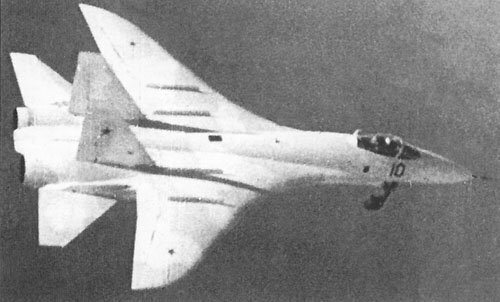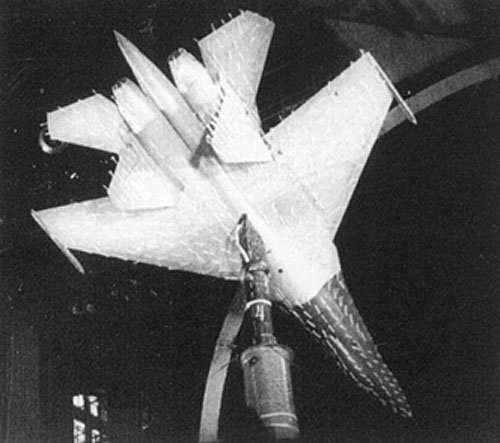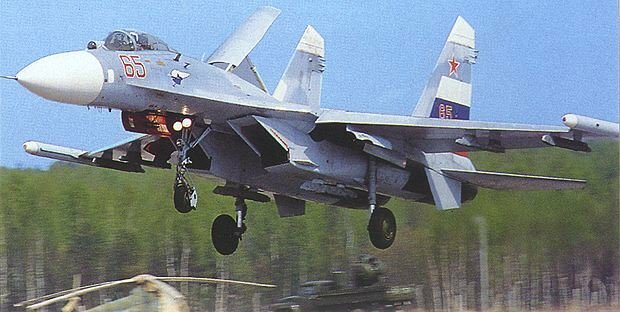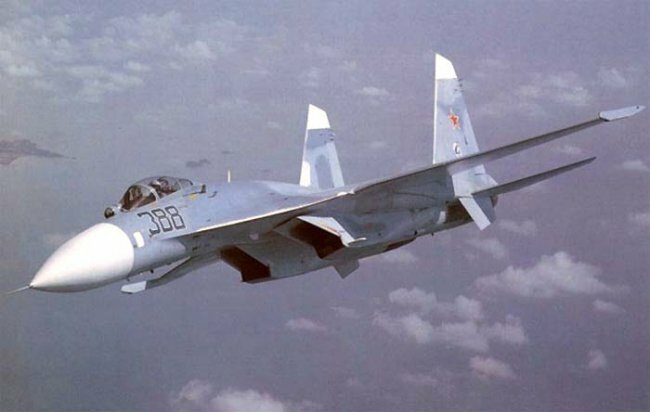Su-27, Flanker-B frontline fighter (Marginal)
By developing a promising fighter of a new generation in the P.O. Dry started in the fall of 1969. It was necessary to take into account that the purpose of the aircraft being created is the struggle for air superiority and that tactics include short-range maneuvering combat, which by that time was again recognized as the main element in the combat use of a fighter. The projected aircraft was designed to give a decent response to the F-15 Eagle, which since 1969, at an accelerated pace, was created by McDonnell Douglas. In addition to the Design Bureau P.O. Sukhoi, the initiative development of the 4 generation of the aircraft was also carried out by other design teams. In 1971, the Air Force announced a competition for projects of a promising front-line fighter (PFI), in which, besides the firm “Su”, OKB A.I. Mikoyan and A.S. Yakovlev. In 1972, the decision is made to give preference to the project T-10 OKB P.O. Dry. By 1974, with the participation of TsAGI specialists, the aerodynamic and design-power schemes of the aircraft were finally formed, and in 1975, the production of working drawings began.
The great merit of the then aerodynamic design managers at the Design Bureau - Deputy Chief Designer I. Baslavsky, Head of the Department M. Khesin, Head of the Brigade L. Chernov was the intention of in-depth study of the flow phenomena of the selected wing of the Gothic form, on which there was no systematic information at that time. If in the USA we already designed (YE-16, YE-117) and flew (F-5E) planes with root wings, in our country we had to deal with this issue from scratch. The fact is that the Gothic wing adopted for the T-10 with a curvilinear leading edge, suitable for cruising in trans-sound and supersonic, contains root flows integrated with the fuselage.
Two engines in separate nacelles were supposed to “hang up” to the lower surface of the wing with keeping a certain distance between the leading edge and the air intake entrance. It was decided to use the rear alignment, which implies the longitudinal static instability of the aircraft, and EDSU. For the first time, a serial Russian aircraft was taken to equip an automated EDSU. He, too, was equipped with a large supply of fuel, tanks for which were located in the center-section and wings, and highly efficient engines, which greatly increased the range of non-stop flight.

After the death of P.O. Sukhoi, the topic of the new fighter since the 1976 year, is headed by MP Simonov. By this time, it becomes clear that the original layout has significant drawbacks. However, the plane with the original layout was nevertheless built and 20 May 1977, the chief pilot OKB P.O. Sukhoi Honored Test Pilot Hero of the Soviet Union V.S. Ilyushin lifted into the air a prototype T-10-1 (NATO code designation - Flanker-A). The plane had a developed influx and an oval-shaped wing in the plan, which made it difficult to apply the leading edge mechanization. The rear edge was occupied by standard mechanization — aileron and flap, and anti-flatter weights were placed on the wing tips. Similar weights are installed on the horizontal and vertical tail. Keels are placed on the upper surfaces of the engine nacelles. The radar radome on the T-10-1 is slightly shorter than on serial machines, and the equipment is serviced through hatches on the side of the LFP. The cockpit canopy moves back along the guides. Since the AL-31F engines, for which the aircraft was designed to be installed, were not yet available, TRD AL-21F-3АИ with the lower box (used on other aircraft of the company: Su-17, Su-24) were installed on this machine.
By January 1978, a program (10 flights) was completed on the T-1-38 to obtain key flight characteristics and information about the stability and controllability of the prototype. In 1985, this aircraft was transferred to the Museum aviation Air Force technicians at the Air Force Academy. Gagarin in the city of Monino. In 1978, the second prototype was assembled - T-10-2. But his fate was not long. On July 7, 1978, during the second flight, the plane, piloted by test pilot and Hero of the Soviet Union Yevgeny Solovyov, fell into the unexplored region of resonance modes. The pilot, trying to save the car died.
 Prototype T-10-3
Prototype T-10-3During 1978, the serial production of the aircraft at the aviation plant them. Yu.A. Gagarin in Komsomolsk-on-Amur. At the same time, two more prototypes are assembled at the experimental design bureau in Moscow. 23 August 1979 of the year T-10-3 (VS Ilyushin) rises in the air, October 31 of the year 1979 - T-10-4. Both cars receive new TRD AL-31F (with the lower box of units), and some aerodynamic improvements. The T-10-3 was later transferred to NITKA for testing under the Su-27K program, and weapons systems were tested on the T-10-4.
At this time, data began to arrive on the American F-15. Unexpectedly, it turned out that the machine does not meet the technical specifications for a number of parameters, and is inferior to the F-15 in many respects. For example, the developers of electronic equipment did not fit into the weight and size frames assigned to them. Also failed to realize a given fuel consumption. There was a difficult dilemma before the developers - either to bring the machine to mass production and hand it over to the customer in its current form, or to undertake a radical reworking of the entire machine.

After the arrival of MP Simonov to the leadership of the topic, and then the Sukhoi Design Bureau, tests were carried out for those days of completely “exotic” aircraft layout options: with wings of negative sweep, with PGO; The engine operation has been simulated. A lot of experiments were carried out to find the means to ensure the direct control of the lifting and lateral forces. At that time, a significant part of TsAGI’s capacity was loaded with work on Buran, therefore, the aerodynamics of the T-10 Sukhoi Design Bureau gave to SibNIA (the work was headed by Stanislavov Kashafutdinov, who later received the State Prize for it), where the pipe was idle. Supersonic blowdowns were carried out in pipes of the Institute of Applied Mechanics of the Siberian Branch of the Academy of Sciences in Akademgorodok.
Meanwhile, in July 1980 of the year at the plant in Komsomolsk-on-Amur, the first machine of the installation batch is assembled - T-10-5. In the same year, the T-10-6, T-10-7, T-10-8 and T-10-9 aircraft were manufactured, and in the 1981 year, the T-10-10 and T-10-11. The entire series is equipped with TRDD AL-21F.
To the credit of the developers of the Sukhoi Design Bureau, they decided to remain loyal to their longstanding traditions and did not release a mediocre machine. In 1979, a new machine is proposed, in the design of which the experience of developing the T-10 and the experimental data obtained were taken into account. 10 April 1981, a prototype T-10-7 (T-10С-1), piloted by VS. Ilyushin rose to the sky. The car has been greatly modified, almost all the nodes are designed from scratch. A new wing with a straight front edge, deflected by a toe, flaperons instead of flaps and ailerons, an additional weapon suspension point instead of an anti-flatter load was installed on it, aerodynamic partitions were removed. The stabilizer tips have received a new form, they have been removed from the anti-flatter weights. Vertical plumage was transferred to tail beams. The radius of the pairing of the wing and fuselage when viewed from the front were increased. Increased internal fuel capacity. The HCHF was changed - a “peak” appeared, in which the brake parachute was placed (it was not installed directly on T-10-7). The chassis has also been redone. New main bearings received an oblique axis of rotation and side locks of the released position. The front support began to get out ahead, and not backward in flight, as was the case with the first cars. The aircraft was equipped with AL-31F engines with the upper gearbox and new air intakes with retractable safety nets. The detachable part of the cockpit canopy began to open up and back. A single brake flap appeared on the upper surface of the fuselage instead of two under the center section, which were simultaneously the flaps of the wheel sections of the main landing gear supports.
Since 1981, all work on the T-10C program has been carried out at the Design Bureau under the direct supervision of Alexey Knyshev, who is the chief designer of the aircraft today.

On the already released cars, it was decided to test the units and systems of the new fighter, to carry out static tests on T-10-8 (T-10С-0, 1982 year), and aerodynamics - on T-10-7 and Т-10-12 (T -10C-2). All of these aircraft were assembled at the Machine-Building Plant named. BY. Dry. 3 September 1981 of the year due to a failure in the fuel system with the T-10-7 crash occurred. Piloted aircraft VS Ilyushin managed to escape. 23 December 1981, in one of the flights in a critical mode, due to the destruction of the glider T-10-12 killed Alexander Komarov. Then, the cause of the accident could not be found out. Later, in the 1983 year, a similar accident befell one of the first production fighter jets - the T-10-17. Only thanks to the great skill of N.F. Sadovnikov, later Hero of the Soviet Union, world record holder, the flight ended successfully. Gardeners planted a damaged aircraft on the airfield - without most of the wing's console, with a chopped off keel - and thus provided invaluable material to the developers of the machine. As a matter of urgency, measures were taken to refine the aircraft: the design of the wing and the airframe as a whole was strengthened, the area of the slat was reduced.
June 2 1982 for the first time flew into the air head serial T-10-15 (future record П-42), in the same year T-10-16 and the above-mentioned T-10-17 gather. In the 1983 the plant in Komsomolsk-on-Amur collects more 9 fighters - T-10-18, T-10-20, T-10-21, T-10-22, T-10-23, T-10-24 , T-10-25, T-10-26 and T-10-27. Most of these aircraft took part in various types of acceptance tests, which ended in the middle of the 80's.

A broad front was carried out on the machine T-10-5. It worked out a new version of the weapon control system: in May, the 1982 of the year, due to the low reliability of the onboard computer and the unsatisfactory performance of the Mech radar antenna, decided to equip the T-10 with a new computing system based on the BTXM 100 developed by NIICUT and the antenna radar, which had to create on the basis of the antenna radar "Rubin" MiG-29. Despite another sharp turn in fate, at the end of the year, the plane received an updated SUV-27, and at the end of 1983, it was presented for joint state tests.
Su-27 is made according to the normal balancing scheme, has an integral aerodynamic layout with a smooth coupling of the wing and the fuselage, forming a single supporting body. All-metal construction with extensive use of titanium alloys. A semi-monocoque fuselage with a circular cross section. The bow end is deflected down. The pilot is located on the ejection seat K-36DM, providing emergency escape of the aircraft in the entire range of altitudes and speeds of flight.
Airplanes can be used to intercept air targets in a large range of altitudes and flight speeds, including against the background of the earth, and to conduct a maneuverable air combat in any weather conditions day and night. For the successful implementation of combat missions on board installed modern aiming equipment. Search and tracking of targets are carried out with the help of RLPK with coherent pulse-Doppler radar or OEPS with OLLS and the helmet-mounted target designation system. The radar has an antenna with a diameter of 1076 mm with electronic scanning in azimuth and mechanical in elevation. Radar is guaranteed to detect air targets of a light fighter class at a distance of 80-100 km in the forward hemisphere and 30-40 km at the rear, accompany up to ten targets on the aisle and ensure simultaneous launch of missiles on two targets. The radar can search for and support targets against the background of the earth or sea surface.

Serial production of the Su-27 with 1983 year was carried out by the aircraft plant them. Yu.A. Gagarin in Komsomolsk-on-Amur (now KnAAPO). In 1984, the first Su-27 entered the armed forces, and by the end of the next year nearly a hundred of these fighters had been released, and a massive re-equipment of the air force and air defense fighter units was launched to a new type of aircraft. The first combatant unit that received the Su-27 was the fighter regiment of the air defense forces, based in 10 km from Komsomolsk-on-Amur. The development of new types of fighters, the development of recommendations for their piloting and combat use, as well as retraining of combatant pilots for them were conducted at TsBPiPLS Air Force in Lipetsk and TsBPiPLS aviation defense in Savasleyka.
State joint tests of the Su-27 ended in the year 1985. The results showed that a truly outstanding aircraft was created that is unmatched in fighter aircraft in terms of maneuverability, flight range and combat effectiveness. However, some systems of avionics, first of all REB equipment, required additional tests. In the process of mass production, the design of the detachable part of the lantern has changed - instead of solid glass there are two parts separated by a binder. Wheels and tires changed, while the size remained unchanged. The thin "fin" was replaced by a thick one; the cartridges of the automatic jamming device APP-50 - 96 pieces instead of 24, which were installed in the "peak", were placed in it. The shape of the keel tip has changed, in connection with which they removed the anti-slip weights from the vertical tail. The composition of weapons was expanded by free-fall bombs caliber 100, 250 and 500 kg, as well as the NAR. A number of other changes have been made. After debugging the entire complex of avionics, the Su-23 was officially adopted by the Air Force and Air Defense of the Soviet Union by a Resolution of the USSR Council of Ministers on 1990 August 27.
After the collapse of the USSR, which had 513 machines like the Su-27, at the beginning of 1992, some of the fighters went to the former Soviet republics: Ukraine (67), Belarus (23), and Uzbekistan. In 1996-2001 in the framework of the compensation program (equipment in exchange for strategic bombers Tu-95MS from under Semipalatinsk and payment for the lease of landfills), Kazakhstan received 26 Su-27 fighters. From the 315 Su-27 fighters, which the Armed Forces of the Russian Federation had for 1995, about 200 were part of the air defense aviation.
The contract for the supply of eight Su-27 / Su-27UB to Ethiopia was signed in the autumn of 1998 of the year (the first four aircraft were delivered in December). However, in this case, not new, but used aircraft from the presence of the Russian Air Force were sold. The supplier was the state enterprise Promeksport. 24 the same aircraft purchased by Syria. In general, from the beginning of 90-x, special export fighter Su-27SK and Spark - Su-27КБК are offered for foreign buyers.
The NATO code designation is Flanker-B (Marginal).


Information